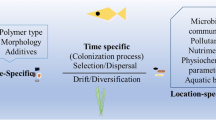Abstract
Cyanobacterial biofilms present on stone surfaces inRoman hypogea were studied with the aim of assessingtheir deteriogenic activity on the colonisedsubstrata. In order to achieve this, non-destructivemethods were developed and applied to measure pHvariation induced via photosynthesis and respirationin representative cyanobacteria from Roman catacombs.Amperometric and potentiometric microsensors were alsoused on Scytonema biofilms in culture in orderto measure photosynthesis and assess pH decreases andincreases during dark–light periods. Measurementsof pH showed that, starting with values slightly belowneutral, the pH in Scytonema biofilms increasedby 0.24–0.77 units in the transition from dark to1000 μmol photon m-2 s-1 irradiance.Comparison of photosynthesis and pH curves recordedsimultaneously on the same artificial biofilm showeda maximum increase in pH value at irradiances higherthan those saturating photosynthesis. Alkalinisationof the substrate during illumination occurred to asufficient extent to induce precipitation of mineralcompounds, especially on calcareous substrates such asthose present in Roman hypogea.
Similar content being viewed by others
References
Albertano P (1993) Epilithic algal communities in hypogean environment. Giorn. Bot. Ital. 127: 385-392.
Albertano P (1998) Deterioration of Roman hypogea by epilithic cyanobacteria and microalgae. In Guarino A et al. (eds), Science and Technology for the Safeguard of Cultural Heritage in the Mediterranean Basin, vol 2, CNR Editions, Palermo, pp. 1303-1308.
Albertano P, Bruno L (1995) Photosynthesis, pigments and ultrastructure of an acclimating Leptolyngbya sp. Giorn. Bot. Ital. 129: 1285-1287.
Albertano P, Compagnone D (1999) Ultrastructural and analytical approaches to the study of stone microbial communities. In Monte M (ed.), Eurocare-Euromarble Proceedings EU 496/8, CNR Editions, Rome, pp. 89-93.
Albertano P, Grilli Caiola M (1989) A hypgean algal association. Braun-Blanquetia 3: 287-292.
Albertano P, Kovacik L (1996) Light and temperature responsis of terrestrial sciaphilous strains of Leptolyngbya sp. in crossgradicent cultures. Arch Hydrobiol, Algological Studies 83: 17-28.
Albertano P, Kovacik L, Marvan P, Grilli Caiola M (1995) A terrestrial epilithic diatom from Roman Catacombs. In Marino D, Montresor M (eds), 13th International Diatom Symp, Biopress, Bristol, pp. 11-21
Albertano P, Luongo L, Grilli Caiola M (1991a) Influence of different lights on mixed cultures of microalgae from ancient frescoes. International Biodeterioration 27: 27-38.
Albertano P, Luongo L, Grilli Caiola M (1991b) Observation on cell structure of microorganisms of an epilithic phototrophic community competing for light. Nova Hedwigia 53: 369-381.
Albertano P, Urzì C (1999) Structural interactions among epilithic cyanobacteria and heterotrophic microorganisms in Roman hypogea. Microbial Ecology 38: 244-252.
Ariño X, Hernandez-Mariné M, Saiz-Jimenez C (1997) Colonization of Roman tombs by calcifying cyanobacteria. Phycologia 36: 366-373.
Bruno L, Albertano P (1996) First data on epilithic heterocystous cyanobacteria from Roman hypogea. Giorn. Bot. Ital. 130: 1013-1015.
Bruno L, Albertano P (1999) Photoacclimation of sciaphilous epilithic cyanobacteria isolated from Roman hypogea. Arch Hydrobiol., Algological Studies 94: 89-103.
Compagnone D, Di Carlo V, Bruno L, Albertano P., Palleschi G (1999) Development of oxygen microsensor for monitoring cyanobacterial photosynthesis in Roman hypogea. Analytical Letters 32: 213-222.
Hoffmann L (1989) Algae of terrestrial habitats. Bot. Revs 55: 77-105.
Lassen C, Glud RN, Ramsing NB, Revsbeck NP (1998) A method to improve the spatial resolution of photosynthetic rates obtained by oxygen microsensors. J. Phycol. 34: 89-93.
Mackinney G (1941) Absorption of light by chlorophyll solutions. J. Biol. Chem., 140: 315-322.
Ortega-Calvo JJ, Hernandez-Mariné M, Saiz-Jimenez C (1993) Cyanobacteria and algae on historic buildings and monuments. In Garg KL, Garg N, Mukerji KG (eds), Recent Advances in Biodeterioration and Biodegradation, Naya Prokash, Calcutta, pp. 173-203.
Revsbeck NP (1994) Analysis of microbial mats by use of electrochemical microsensor: recent advances. In Stal LP, Caumette P (eds), Microbial Mats, NATO ASI Series G-35, Springer Verlag, Berlin-Heidelberg, pp. 135-147.
Rippka R, Deruelles J, Waterbury JB, Herdman M, Stanier RY (1979) Generic assignments, strain histories and properties of pure cultures of cyanobacteria. J. gen. Microbiol. 111: 1-61.
Schneider J, Le Campion-Alsumard T (1999) Construction and destruction of carbonates by marine and freshwater cyanobacteria. Eur. J. Phycol. 34: 417-426.
Whitton BA (1992) Diversity, ecology and taxonomy of the cyanobacteria. In Carr NG, Mann N (eds), Photosynthetic Prokaryotes, Plenum Press, New York, pp. 1-51.
Author information
Authors and Affiliations
Rights and permissions
About this article
Cite this article
Albertano, P., Bruno, L., D'Ottavi, D. et al. Effect of photosynthesis on pH variation in cyanobacterial biofilms from Roman catacombs. Journal of Applied Phycology 12, 379–384 (2000). https://doi.org/10.1023/A:1008149529914
Issue Date:
DOI: https://doi.org/10.1023/A:1008149529914




